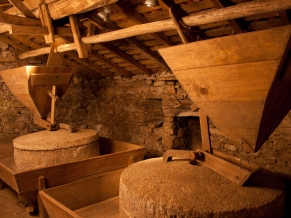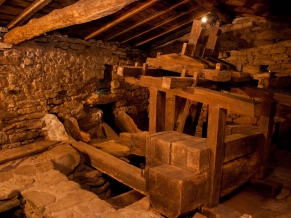- Home
- Experiences
- Places of interest
- The Fulling mills of Mosquetín: weaving...
The Fulling mills of Mosquetín: weaving paths
The Fulling mills of Mosquetín: weaving paths
Next to the Río Grande river, we see the Fulling mills of Mosquetín, an ethnographic monument consisting of three fulling mills and six mills. The fulling mills were used during the late 18th and early 19th centuries, to full fabrics: linen and woollen pieces were beaten to reduce their volume and thus make them denser and firmer.
The mechanisms of the fulling mills were powered by the flowing waters of the Rio Grande, rotating a hydraulic wheel that lifted the hammers to beat and compact fabric.
Along with the fulling mills, and among the rocks, bushes and trees, there are six flour mills, very common in Galicia, which are used by the locals from Soneira, Bergantiños, the area of Xallas and ria of Noia to grind grain.
These mills are an example of popular engineereing, demonstrating the insight of the ancient Vimianzo inhabitants, who took advantage of water power for the benefit of the local artisan industry, very traditional in Vimianzo, with highlights being the bobbin laces made by the local 50 or so paililleiras.
In 1997 the whole site of the Fulling mills of Mosquetín underwent a rehabilitation process sponsored by the A Coruña Provincial Council, paired with the construction of an interpretation centre.
Information about schedules, contact and others: www.vimianzo.gal/turismo


